In Situ Thermal Transmittance Assessment of the Building Envelope: Practical Advice and Outlooks for Standard and Innovative Procedures
Abstract
1. Introduction
2. Aims and Methods
- Providing a comprehensive review and classification of the techniques for the U-value measurement.
- Updating previous review studies, including some recent works that propose new methods.
- Highlighting the prospective that AI and the data-driven method currently open for the U-value retrieval or assessment.
- Visualizing the linking between the methods.
- Bibliometric and scientometric analysis of the topic based on the Scopus database, which helped in query definition and refinement. Results have been analyzed and displayed by using statistical analysis and science mapping (Section 3).
- Detailed and critical discussion of the topic, with a deeper description of the most relevant studies in the literature on both widely used and innovative techniques (Section 4).
- Identification of future perspectives (Section 4).
3. Bibliometric and Scientometric Analysis
- Number of studies.
- Evolution of the studies during time.
- Geographic provenience and distribution of the publications.
- Authors.
- Indexed keywords.
3.1. Bibliometric Analysis
3.2. Scientometric Analysis
4. U-Value Assessment
- Estimation realized without a measuring campaign. This group includes the analogy with coeval buildings and the theoretical method.
- Measurement or test realized with a measuring campaign, whether ruled by standard (e.g., HFM measurements and QIRT) or not, such as the simple hot box and thermometric methods.
- Innovative procedures that have been recently proposed in the literature, which require measurement and are quite a combination between HFM and QIRT. These are the representative points method and weighted area method.
- The future perspective of all the previous, which basically rest on the use of AI and the use of data, such as random forest, artificial neural network (ANN), and so on.
4.1. Group 1: Estimation
- Analogy with coeval buildings (Section 4.1.1).
- Theoretical method (Section 4.1.2).
4.1.1. Analogy with Coeval Buildings
4.1.2. Theoretical Method
4.2. Group 2: Measurement
- Heat flow meter measurement (Section 4.2.1).
- Simple hot box method (Section 4.2.2).
- Thermometric method (Section 4.2.3).
- Quantitative infrared thermography (Section 4.2.4).
4.2.1. Heat Flow Meter Measurement
4.2.2. Simple Hot Box Method
4.2.3. Thermometric Method
4.2.4. Quantitative Infrared Thermography
4.3. Group 3: Innovative Procedures
4.3.1. Representative Points Method (RPM)
4.3.2. Weighted Area Method (WAM)
4.4. Group 4: Future Perspectives
5. Discussion
6. Conclusions
- Estimation techniques (which include analogy with coeval building and the theoretical method) are well-assessed and -used, as they allow a quick evaluation of the U-value. They provide ranges of variability of the U-value, not a specific value. Uncertainties are due to missing or incomplete or hypothesized data, such as building period, building features, layer thickness, and material characteristics.
- Analogy with coeval building is less accurate, but it is sufficient for quick assessments, for instance for obtaining in a glance the order of magnitude of the energy transmission of the building isle, similarly aged.
- Importance of complete databases for collecting and sharing data from different building typologies, ranging for age and region. Some winning experiences are milestones for this approach (e.g., TABULA), but even other databases realized at national or local scale, or even for other purposes (e.g., CARTIS), can provide useful information.
- Importance of sharing data among databases. For instance, databases built for purposes other than energy efficiency (like seismic analysis or post-seismic scenarios) can provide capillary information at local scale, entailing even field surveys.
- The theoretical method requires a detailed knowledge of the wall stratigraphy, made possible, for instance, by coring, endoscope, or using air duct holes. Where it is not possible to have such detailed information, it is possible to refer to typical data, so referring to the analogy with coeval buildings.
- Measurement methods (which include the heat flux meter measurement, simple hot box, quantitative infrared thermography, and thermometric method) suffer for typical uncertainties, such as operative conditions (that might differ from the ideal ones or from those prescribed by standards), equipment misfunctioning, data cleaning, or subjective interpretation from the worker.
- Heat flux meter (HFM) measurement is well-known and assessed: the standard provides rules and recommendations, and the literature is enlarging the possibilities of this method. It is a long-lasting technique, especially for heavy walls, and duration can be also compromised by boundary environmental condition. However, HFM data already gathered from both researchers and practitioners can be included in databases, where data can be also georeferenced; it is even better if they are made open-access.
- The thermometric method is still not ruled by an international standard, and it is quite simple to use as it requires only to measure one quantity: the temperature. Hence, the heat flux is not directly measured, like the HFM. Some researchers have proved that measurement duration can be reduced to a few hours when particular boundary conditions are met. Moreover, some self-made equipment opens the possibility of scaling up the number of measurement points, with restrained cost (besides those for engineering).
- The simple hot box (SHB) method avoids the strict dependency of the HFM to boundary conditions, but this is realized by using a device (the box), whose positioning might be complex. In fact, the box is mounted on a support structure that needs to rest on the ground. Hence, walls of buildings not on the ground floor or without balconies are not investigable with this technique.
- The quantitative infrared thermography (QIRT) technique is now ruled by a standard, but it still represents an open research field (indoor/outdoor QIRT, convective coefficient correlation, lasting, etc.). If some boundary conditions are met, it allows a rapid evaluation of several buildings. Unfortunately, the needed equipment (the IR camera) is expensive for accurate measurement, although it can be used for several other purposes and investigations.
- The representative points method (RPM) and weighted area method (WAM) are similar for the approach, as they are based on IRT for accurate temperature profile definition but perform the measurement via HFM. In this sense, these two techniques merge QIRT and HFM. They have been successfully employed on lightweight walls, providing low error (0–8%).
- Artificial intelligence (AI) and artificial neural networks (ANNs) require a good knowledge of AI potentials and a dataset retrieved by in situ measurement. In this sense, this approach needs further development and a data source. The literature on the application of AI for U-value assessment is still scarce, so it can be a good investigation field.
- Approaches are linked, and the U-value assessment can include more than one method per time.
- Convection is a key point for all the measurement techniques. The convective coefficient is a key point for all the techniques (except for SHB-HFM, which reproduces at small-scale laboratory conditions). Its theoretical value might be different from the one occurring in situ. The research activities, for all the listed measurement methods, are devoted to find proper or better correlations and, hence, the coefficient to be used.
- Test duration can vary, also considering the wall thermal inertia.
- Test duration can be reduced, if data collected during short-term campaigns are good enough for the feed and artificial neural network.
- Approaches with artificial intelligence are still not so common. They require good datasets and trials on models’ designs, in terms of input layer, number of hidden layers and neurons, percentage of data to be employed for model training and testing, and so on.
- An integrated approach using AI and thermal imagery has been proposed. This method, however, requires also collecting annotations on the building and on the thermal images.
- Attempts for automatic thermal images processes can be undertaken (the literature from other fields, such as material testing, will be of help), also, to reduce the processing time.
Author Contributions
Funding
Data Availability Statement
Conflicts of Interest
Nomenclature
| U-value or U | Thermal transmittance (W/(m2 K)) |
| R-value or R | Thermal resistance (W/(m2 K)) |
| HFM | Heat flux meter |
| QIRT | Quantitative infrared thermography |
| IRT | Infrared Thermography |
| SHB | Small hot box |
| RPM | Representative points method |
| WAM | Weighted area method |
| AI | Artificial intelligence |
| ANN | Artificial neural network |
| RNN | Recurrent neural network |
| TITLE-ABS-KEY | Title, abstract, keywords |
| KEY | Keywords |
| LDT | Low-destructive technique |
| NDT | Non-destructive technique |
| TBM | Temperature-based method |
| ASTR | Air–surface temperature ratio |
| RPM | Representative points method |
| WAM | Weighted area method |
| LSTM | Long-short term memory |
| GRU | Gated recurrent units |
| mAP | Mean average precision |
| mIoU | Mean intersection over union |
| UAV | Unmanned aerial vehicle |
| s | Layer thickness (m) |
| λ or λ-value | Thermal conductivity ((mK)/W) |
| q | Heat flux (W/m2) |
| Tin | Indoor air temperature (K) |
| Tout | Outdoor air temperature (K) |
| Tref | Reflected temperature (K) |
| Ts | Surface temperature (K) |
| Ta | Generic air temperature (K) |
| ΔTs | Surface temperature difference (K) |
| ΔTa | Air temperature difference |
| σ | Stefan–Boltzmann constant (W/(m2 K4)) |
| hin | Indoor convective heat transfer coefficient (W/(m2 K)) |
| ε | emissivity |
| Ra | Rayleigh number |
| Pr | Prandtl number |
| L | Wall height (m) |
| v | Air speed (m/s) |
References
- IEA. Buildings; Tracking Report—September 2022; IEA: Paris, France, 2022. Available online: https://www.iea.org/reports/buildings (accessed on 21 February 2023).
- Lucchi, E. Applications of the infrared thermography in the energy audit of buildings: A review. Renew. Sustain. Energy Rev. 2018, 82, 3077–3090. [Google Scholar] [CrossRef]
- Nardi, I.; Lucchi, E.; de Rubeis, T.; Ambrosini, D. Quantification of heat energy losses through the building envelope: A state-of-the-art analysis with critical and comprehensive review on infrared thermography. Build. Environ. 2018, 146, 190–205. [Google Scholar] [CrossRef]
- Standard ISO 6946; Building Components and Building Elements. Thermal Transmittance and Thermal Resistance. Calculation Method. ISO (International Organization for Standardization): Genève, Switzerland, 2008.
- Bienvenido-Huertas, D.; Moyano, J.; Marín, D.; Fresco-Contreras, R. Fresco-Contreras Review of in situ methods for assessing the thermal transmittance of walls. Renew. Sustain. Energy Rev. 2019, 102, 356–371. [Google Scholar] [CrossRef]
- Teni, M.; Krstić, H.; Kosiński, P. Review and comparison of current experimental approaches for in-situ measurements of building walls thermal transmittance. Energy Build. 2019, 203, 109417. [Google Scholar] [CrossRef]
- Simões, N.; Moghaddam, A.; da Silva, M.G. Review of the Experimental Methods for Evaluation of Windows’ Thermal Transmittance: From Standardized Tests to New possibilities. Buildings 2023, 13, 703. [Google Scholar] [CrossRef]
- Falagas, M.E.; Pitsouni, E.I.; Malietzis, G.A.; Pappas, G. Comparison of PubMed, Scopus, Web of Science, and Google Scholar: Strengths and weaknesses. FASEB J. 2008, 22, 338–342. [Google Scholar] [CrossRef]
- Cabeza, L.F.; Chàfer, M.; Mata, É. Comparative analysis of web of science and Scopus on the energy efficiency and climate impact of buildings. Energies 2020, 13, 409. [Google Scholar] [CrossRef]
- Andersen, N.; Swami, V. Science mapping research on body image: A bibliometric review of publications in Body Image, 2004–2020. Body Image 2021, 38, 106–119. [Google Scholar] [CrossRef] [PubMed]
- Ascione, F.; Bianco, N.; De Masi, R.F.; Mauro, G.M.; Musto, M.; Vanoli, G.P. Experimental validation of a numerical code by thin film heat flux sensors for the resolution of thermal bridges in dynamic conditions. Appl. Energy 2014, 124, 213–222. [Google Scholar] [CrossRef]
- Ascione, F.; Ceroni, F.; De Masi, R.F.; de’Rossi, F.; Pecce, M.R. Historical buildings: Multidisciplinary approach to structural/energy diagnosis and performance assessment. Appl. Energy 2017, 185, 1517–1528. [Google Scholar] [CrossRef]
- Siviour, J.B. Experimental U-values of some house walls. Build. Serv. Eng. Res. Technol. 1994, 15, 35–36. [Google Scholar] [CrossRef]
- Cesaratto, P.G.; De Carli, M. A measuring campaign of thermal conductance in situ and possible impacts on net energy demand in buildings. Energy Build. 2013, 59, 29–36. [Google Scholar] [CrossRef]
- Doran, S. Safety and Health Business Plan: Field investigations of the thermal performance of construction elements as built. BRE East Kilbride Glasg. 2001, 78132. [Google Scholar]
- Rye, C.; Scott, C. SPAB Research Report n.1: U-Value Report; SPAB: London, UK, 2011. [Google Scholar]
- Lucchi, E. Non-invasive method for investigating energy and environmental performances in existing buildings. In Architecture and Sustainable Development, Proceedings of the 27th International Conference on Passive and Low Energy Architecture, Louvain-la-Neuve, Belgium, 13–15 July 2011—PLEA 2011; Bodart, M., Evrard, A., Eds.; Presses Universitaires de Louvain: Louvain-la-Neuve, Belgium; pp. 571–576.
- Rhee-Duverne, S.; Baker, P. Research into the Thermal Performance of Traditional Brick Walls; English Heritage: London, UK, 2013. [Google Scholar]
- Lucchi, E. Thermal transmittance of historical brick masonries: A comparison among standard data, analytical calculation procedures, and in situ heat flow meter measurements. Energy Build. 2017, 134, 171–184. [Google Scholar] [CrossRef]
- Lucchi, E. Thermal transmittance of historical stone masonries: A comparison among standard, calculated and measured data. Energy Build. 2017, 151, 393–405. [Google Scholar] [CrossRef]
- TABULA Database. Available online: https://episcope.eu/welcome (accessed on 24 February 2023).
- Available online: https://webtool.building-typology.eu/#bm (accessed on 24 February 2023).
- Available online: https://episcope.eu/iee-project/episcope/ (accessed on 15 March 2023).
- Available online: https://www.protezionecivile.gov.it/it/approfondimento/scheda-aedes (accessed on 15 March 2023).
- Brando, G.; Cianchino, G.; Rapone, D.; Spacone, E.; Biondi, S. A CARTIS-based method for the rapid seismic vulnerability assessment of the minor Italian historical centres. Int. J. Disaster Risk Reduct. 2021, 63, 102478. [Google Scholar] [CrossRef]
- Basaglia, A.; Cianchino, G.; Cocco, G.; Rapone, D.; Terrenzi, M.; Spacone, E.; Brando, G. An automatic procedure for deriving building portfolios using the Italian “CARTIS” online database. Structures 2021, 34, 2974–2986. [Google Scholar] [CrossRef]
- Sassine, E. A practical method for in-situ thermal characterization of walls. Case Stud. Therm. Eng. 2016, 8, 84–93. [Google Scholar] [CrossRef]
- Litti, G.; Khoshdel, S.; Audenaert, A.; Braet, J. Hygrothermal performance evaluation of traditional brick masonry in historic buildings. Energy Build. 2015, 105, 393–411. [Google Scholar] [CrossRef]
- Standard UNI 10351; Materiali da costruzione—Proprietà termoigrometriche—Procedura per la Scelta dei Valori di Progetto. UNI (Ente Italiano di Normazione): Milano, Italy, 2021.
- Ficco, G.; Iannetta, F.; Ianniello, E.; Alfano, F.; Dell’Isola, M. U-value in situ measurement for energy diagnosis of existing buildings. Energy Build. 2015, 104, 108–121. [Google Scholar] [CrossRef]
- Standard ISO 9869; Thermal Insulation. Building Elements. In-Situ Measurement of Thermal Resistance and Thermal Transmittance. ISO (International Organization for Standardization): Genève, Switzerland, 2014.
- Standard ISO 6781; Thermal Insulation. Qualitative Detection of Thermal Irregularities in Building Envelopes. Infrared Method. ISO (International Organization for Standardization): Genève, Switzerland, 1983.
- Baker, P. U-Values and Traditional Buildings: In Situ Measurements and Their Comparisons to Calculated Values; Historic Scotland: Edinburgh, UK, 2011.
- Lucchi, E.; Roberti, F.; Troi, A. Definition of an experimental procedure with the hot box method for the thermal performance evaluation of inhomogeneous walls. Energy Build. 2018, 179, 99–111. [Google Scholar] [CrossRef]
- Williamson, J.B.; Stinson, J.; Garnier, C.; Currie, J. In-situ monitoring of thermal refurbishment on pre-1919 properties in Scotland. Edinb. Scott. Energy Cent. 2013, 2, 26–33. [Google Scholar]
- Adhikari, R.; Lucchi, E.; Pracchi, V. Experimental Measurements on Thermal Transmittance of the Opaque Vertical Walls in the Historical Buildings. In Proceedings of the PLEA 2012—28th Conference, Opportunities, Limits & Needs Towards an Environmentally Responsible Architecture, Lima, Peru, 7–9 November 2012; Reiser, J., Jiménez, C., Biondi Antúnez de Mayolo, S., Eds.; pp. 1248–1256. [Google Scholar]
- Cesaratto, P.; De Carli, M.; Marinetti, S. Effect of different parameters on the in situ thermal conductance evaluation. Energy Build. 2011, 43, 1792–1801. [Google Scholar] [CrossRef]
- Rodler, A.; Guernouti, S.; Musy, M. Bayesian inference method for in situ thermal conductivity and heat capacity identification: Comparison to ISO standard. Constr. Build. Mater. 2019, 196, 574–593. [Google Scholar] [CrossRef]
- Ahmad, A.; Maslehuddin, M.; Al-Hadhrami, L.M. In situ measurement of thermal transmittance and thermal resistance of hollow reinforced precast concrete walls. Energy Build. 2014, 84, 132–141. [Google Scholar] [CrossRef]
- Building Research Establishment (BRE). Field Investigations of the Thermal Performance of Construction Elements as Built; Client Report No. 78132; BRE: Watford, UK, 2000. [Google Scholar]
- Baker, P. In Situ U-Value Measurements in Traditional Buildings, Preliminary Results; Historic Scotland: Edinburgh, UK, 2008.
- Andreotti, M.; Calzolari, M.; Davoli, P.; Dias Pereira, L.; Lucchi, E.; Malaguti, R. Design and construction of a new metering hot box for the hygrothermal measurement in dynamic condition of historic masonries. Energies 2020, 13, 2950. [Google Scholar] [CrossRef]
- Tejedor, B.; Lucchi, E.; Bienvenido-Huertas, D.; Nardi, I. Non-destructive techniques (NDT) for the diagnosis of heritage buildings: Traditional procedures and futures perspectives. Energy Build. 2022, 263, 112029. [Google Scholar] [CrossRef]
- Vereecken, E.; Roels, S. A comparison of the hygric performance of interior insulation systems: A hot box–cold box experiment. Energy Build. 2014, 80, 37–44. [Google Scholar] [CrossRef]
- Meng, X.; Gao, Y.; Wang, Y.; Yan, B.; Zhang, W.; Long, E. Feasibility experiment on the simple hot box-heat flow meter method and the optimization based on simulation reproduction. Appl. Therm. Eng. 2015, 83, 48–56. [Google Scholar] [CrossRef]
- Meng, X.; Luo, T.; Gao, Y.; Zhang, W.; Shen, E.; Long, E. A new simple method to measure wall thermal transmittance in situ and its adaptability analysis. Appl. Therm. Eng. 2017, 122, 747–757. [Google Scholar] [CrossRef]
- Roque, E.; Vicente, R.; Almeida RM, S.F.; Mendes da Silva, J.; Vaz Ferreira, A. Thermal characterisation of traditional wall solution of built heritage using the simple hot box-heat flow meter method: In situ measurements and numerical simulation. Appl. Therm. Eng. 2020, 169, 114935. [Google Scholar] [CrossRef]
- Andújar Márquez, J.M.; Martínez Bohórquez, M.Á.; Gómez Melgar, S. A New Metre for Cheap, Quick, Reliable and Simple Thermal Transmittance (U-Value) Measurements in Buildings. Sensors 2017, 17, 2017. [Google Scholar] [CrossRef]
- Kim, S.H.; Kim, J.H.; Jeong, H.G.; Song, K.D. Reliability field test of the air–surface temperature ratio method for in situ measurement of U-values. Energies 2018, 11, 803. [Google Scholar] [CrossRef]
- Kim, S.H.; Lee, J.H.; Kim, J.H.; Yoo, S.H.; Jeong, H.G. The feasibility of improving the accuracy of in situ measurements in the air-surface temperature ratio method. Energies 2018, 11, 1885. [Google Scholar] [CrossRef]
- Evangelisti, L.; Scorza, A.; De Lieto Vollaro, R.; Sciuto, S.A. Comparison between Heat Flow Meter (HFM) and Thermometric (THM) Method for Building Wall Thermal Characterization: Latest Advances and Critical Review. Sustainability 2022, 14, 693, Erratum in Sustainability 2022, 14, 13398. [Google Scholar] [CrossRef]
- Bienvenido-Huertas, D.; Rodríguez-Álvaro, R.; Moyano, J.J.; Fernando, R.; Marín, D. Determining the U-Value of Façades Using the Thermometric Method: Potentials and Limitations. Energies 2018, 11, 360. [Google Scholar] [CrossRef]
- Vučićević, B.; Turanjanin, V.; Bakić, V.; Jovanović, M.; Stevanović, Ž. Experimental and numerical modelling of thermal performance of a residential building in Belgrade. Therm. Sci. 2009, 13, 245–252. [Google Scholar] [CrossRef]
- Cuerda, E.; Guerra-Santin, O.; Neila, F.J.; Romero, N. Evaluation and comparison of building performance in use through on-site monitoring and simulation modelling. In Proceedings of the 3rd IBPSA-England Conference BSO 2016, Newcastle, UK, 12–14 September 2016. [Google Scholar]
- Buzatu, G.; Stan-Ivan, F.; Mircea, P.; Manescu, L. Thermal transmittance determination for different components of buildings. In Proceedings of the 2017 International Conference on Optimization of Electrical and Electronic Equipment (OPTIM) & 2017 Intl Aegean Conference on Electrical Machines and Power Electronics (ACEMP), Brasov, Romania, 25–27 May 2017; pp. 227–232. [Google Scholar]
- Jankovic, A.; Antunovic, B.; Preradovic, L. Alternative method for on site evaluation of thermal transmittance. Facta Univ. Ser. Mech. Eng. 2017, 15, 341–351. [Google Scholar] [CrossRef]
- Kirimtat, A.; Krejcar, O. A review of infrared thermography for the investigation of building envelopes: Advances and prospects. Energy Build. 2018, 176, 390–406. [Google Scholar] [CrossRef]
- Fokaides, P.A.; Kalogirou, S.A. Application of infrared thermography for the determination of the overall heat transfer coefficient (U-Value) in building envelopes. Appl. Energy 2011, 88, 4358–4365. [Google Scholar] [CrossRef]
- Ham, Y.; Golparvar-Fard, M. An automated vision-based method for rapid 3D energy performance modeling of existing buildings using thermal and digital imagery. Adv. Eng. Inform. 2013, 27, 395–409. [Google Scholar] [CrossRef]
- Tzifa, V.; Papadakos, G.; Papadopoulou, A.G.; Marinakis, V.; Psarras, J. Uncertainty and method limitations in a short-time measurement of the effective thermal transmittance on a building envelope using an infrared camera. Int. J. Sustain. Energy 2017, 36, 28–46. [Google Scholar] [CrossRef]
- Danielski, I.; Fröling, M. Diagnosis of Buildings’ Thermal Performance—A Quantitative Method Using Thermography Under Non-steady State Heat Flow. Energy Procedia 2015, 83, 320–329. [Google Scholar] [CrossRef]
- Tejedor, B.; Casals, M.; Gangolells, M.; Roca, X. Quantitative internal infrared thermography for determining in-situ thermal behaviour of façades. Energy Build. 2017, 151, 187–197. [Google Scholar] [CrossRef]
- Marshall, A.; Francou, J.; Fitton, R.; Swan, W.; Owen, J.; Benjaber, M. Variations in the U-Value Measurement of a Whole Dwelling Using Infrared Thermography under Controlled Conditions. Buildings 2018, 8, 46. [Google Scholar] [CrossRef]
- Tejedor, B.; Casals, M.; Gangolells, M. Assessing the influence of operating conditions and thermophysical properties on the accuracy of in-situ measured U-values using quantitative internal infrared thermography. Energy Build. 2018, 171, 64–75. [Google Scholar] [CrossRef]
- Albatici, R.; Tonelli, A.M.; Chiogna, M. A comprehensive experimental approach for the validation of quantitative infrared thermography in the evaluation of building thermal transmittance. Appl. Energy 2015, 141, 218–228. [Google Scholar] [CrossRef]
- Nardi, I.; Ambrosini, D.; de Rubeis, T.; Sfarra, S.; Perilli, S.; Pasqualoni, G. A comparison between thermographic and flow-meter methods for the evaluation of thermal transmittance of different wall constructions. J. Phys. Conf. Ser. 2015, 655, 012007. [Google Scholar] [CrossRef]
- Albatici, R.; Tonelli, A.M. Infrared thermovision technique for the assessment of thermal transmittance value of opaque building elements on site. Energy Build. 2010, 42, 2177–2183. [Google Scholar] [CrossRef]
- Dall’O’, G.; Sarto, L.; Panza, A. Infrared Screening of Residential Buildings for Energy Audit Purposes: Results of a Field Test. Energies 2013, 6, 3859–3878. [Google Scholar] [CrossRef]
- Nardi, I.; Sfarra, S.; Ambrosini, D. Quantitative thermography for the estimation of the U-value: State of the art and a case study. J. Phys. Conf. Ser. 2014, 547, 012016. [Google Scholar] [CrossRef]
- Kim, J.; Lee, J.; Jang, C.; Jeong, H.; Song, D. Appropriate conditions for determining the temperature difference ratio via infrared camera. Build. Serv. Eng. Res. Technol. 2015, 37, 272–287. [Google Scholar] [CrossRef]
- Marino, B.M.; Muñoz, N.; Thomas, L.P. Estimation of the surface thermal resistances and heat loss by conduction using thermography. Appl. Therm. Eng. 2017, 114, 1213–1221. [Google Scholar] [CrossRef]
- Mahmoodzadeh, M.; Gretka, V.; Hay, K.; Steele, C.; Mukhopadhyaya, P. Determining overall heat transfer coefficient (U-Value) of wood-framed wall assemblies in Canada using external infrared thermography. Build. Environ. 2021, 199, 107897. [Google Scholar] [CrossRef]
- Yang, Y.; Wu, T.V.; Sempey, A.; Dumoulin, J.; Batsale, J.-C. Short time non-destructive evaluation of thermal performances of building walls by studying transient heat transfer. Energy Build. 2019, 184, 141–151. [Google Scholar] [CrossRef]
- Tejedor, B.; Lucchi, E.; Nardi, I. Application of Qualitative and Quantitative Infrared Thermography at Urban Level: Potential and Limitations. In New Technologies in Building and Construction; Lecture Notes in Civil Engineering; Bienvenido-Huertas, D., Moyano-Campos, J., Eds.; Springer: Singapore, 2022; Volume 258. [Google Scholar]
- Bienvenido-Huertas, D.; Bermúdez, J.; Moyano, J.; Marín, D. Comparison of quantitative IRT to estimate U-value using different approximations of ECHTC in multi-leaf walls. Energy Build. 2019, 184, 99–113. [Google Scholar] [CrossRef]
- Baldinelli, G.; Bianchi, F.; Rotili, A.; Costarelli, D.; Seracini, M.; Vinti, G.; Asdrubali, F.; Evangelisti, L. A model for the improvement of thermal bridges quantitative assessment by infrared thermography. Appl. Energy 2018, 211, 854–864. [Google Scholar] [CrossRef]
- Bianchi, F.; Baldinelli, G.; Asdrubali, F. A quantitative infrared thermography method for the assessment of windows thermal transmittance methodology. In Proceedings of the 10th International Conference on Applied and Theoretical Mechanics, Salerno, Italy, 3–5 June 2014; pp. 137–143. [Google Scholar]
- Asdrubali, F.; Baldinelli, G.; Bianchi, F.; Costarelli, D.; Rotili, A.; Seracini, M.; Vinti, G. Detection of thermal bridges from thermographic images by means of image processing approximation algorithms. Appl. Math. Comput. 2018, 317, 160–171. [Google Scholar] [CrossRef]
- Nardi, I.; Ambrosini, D.; Paoletti, D.; Sfarra, S. Combining infrared thermography and numerical analysis for evaluating thermal bridges in buildings: A case study. Int. J. Eng. Res. Appl. 2015, 5, 67–76. [Google Scholar]
- François, A.; Ibos, L.; Feuillet, V.; Meulemans, J. Building thermal bridge heat losses quantification by infrared thermography, Steady-state evaluation and uncertainty calculation. J. Phys. Conf. Ser. 2019, 1343, 012171. [Google Scholar] [CrossRef]
- O’Grady, M.; Lechowska, A.A.; Harte, A.M. Infrared Thermography Technique as an in-situ method of assessing the heat loss through thermal bridging. Energy Build. 2017, 135, 20–32. [Google Scholar] [CrossRef]
- O’Grady, M.; Lechowska, A.A.; Harte, A.M. Quantification of heat losses through building envelope thermal bridges influenced by wind velocity using the outdoor infrared thermography technique. Appl. Energy 2017, 208, 1038–1052. [Google Scholar] [CrossRef]
- Baldinelli, G.; Bianchi, F. Windows thermal resistance: Infrared thermography aided comparative analysis among finite volumes simulations and experimental methods. Appl. Energy 2014, 136, 250–258. [Google Scholar] [CrossRef]
- Park, S.; Kim, S.; Jeong, H.; Do, S.L.; Kim, J. In Situ Evaluation of the U-Value of a Window Using the Infrared Method. Energies 2021, 14, 1904. [Google Scholar] [CrossRef]
- O’Grady, M.; Lechowska, A.A.; Harte, A.M. Application of infrared thermography technique to the thermal assessment of multiple thermal bridges and windows. Energy Build. 2018, 168, 347–362. [Google Scholar] [CrossRef]
- Atsonios, I.A.; Mandilaras, I.D.; Kontogeorgos, D.A.; Founti, M.A. Two new methods for the in-situ measurement of the overall thermal transmittance of cold frame lightweight steel-framed walls. Energy Build. 2018, 170, 183–194. [Google Scholar] [CrossRef]
- Al-Habaibeh, A.; Sen, A.; Chilton, J. Evaluation tool for the thermal performance of retrofitted buildings using an integrated approach of deep learning artificial neural networks and infrared thermography. Energy Built Environ. 2021, 2, 345–365. [Google Scholar] [CrossRef]
- Buratti, C.; Barelli, L.; Moretti, E. Application of artificial neural network to predict thermal transmittance of wooden windows. Appl. Energy 2012, 98, 425–432. [Google Scholar] [CrossRef]
- Bienvenido-Huertas, D.; Pérez-Ordóñez, J.L.; Moyano, J.; Seara-Paz, S. Towards an in-situ evaluation methodology of thermal resistance of basement walls in buildings. Energy Build. 2020, 208, 109643. [Google Scholar] [CrossRef]
- Palladino, D.; Nardi, I.; Buratti, C. Artificial neural network for the thermal comfort index prediction: Development of a new simplified algorithm. Energies 2020, 13, 17. [Google Scholar] [CrossRef]
- Gumbarević, S.; Milovanović, B.; Gaši, M.; Bagarić, M. Application of Multilayer Perceptron Method on Heat Flow Method Results for Reducing the in-situ Measurement Time. Eng. Proc. 2020, 2, 8272. [Google Scholar]
- Gumbarević, S.; Milovanović, B.; Gaši, M.; Bagarić, M. Thermal Transmittance Prediction Based on the Application of Artificial Neural Networks on Heat Flux Method Results. 2021. Available online: http://arxiv.org/abs/2103.14995 (accessed on 16 March 2023).
- Bienvenido-Huertas, D.; Rubio-Bellido, C.; Pérez-Ordóñez, J.L.; Moyano, J. Optimizing the evaluation of thermal transmittance with the thermometric method using multilayer perceptrons. Energy Build. 2019, 198, 395–411. [Google Scholar] [CrossRef]
- Bienvenido-Huertas, D.; Moyano, J.; Rodríguez-Jiménez, C.E.; Marín, D. Applying an artificial neural network to assess thermal transmittance in walls by means of the thermometric method. Appl. Energy 2019, 233–234, 1–14. [Google Scholar] [CrossRef]
- Sadhukhan, D.; Peri, S.; Sugunaraj, N.; Biswas, A.; Selvaraj, D.F.; Koiner, K.; Rosener, A.; Dunlevy, M.; Goveas, N.; Flynn, D.; et al. Estimating surface temperature from thermal imagery of buildings for accurate thermal transmittance (U-value): A machine learning perspective. J. Build. Eng. 2020, 32, 101637. [Google Scholar] [CrossRef]
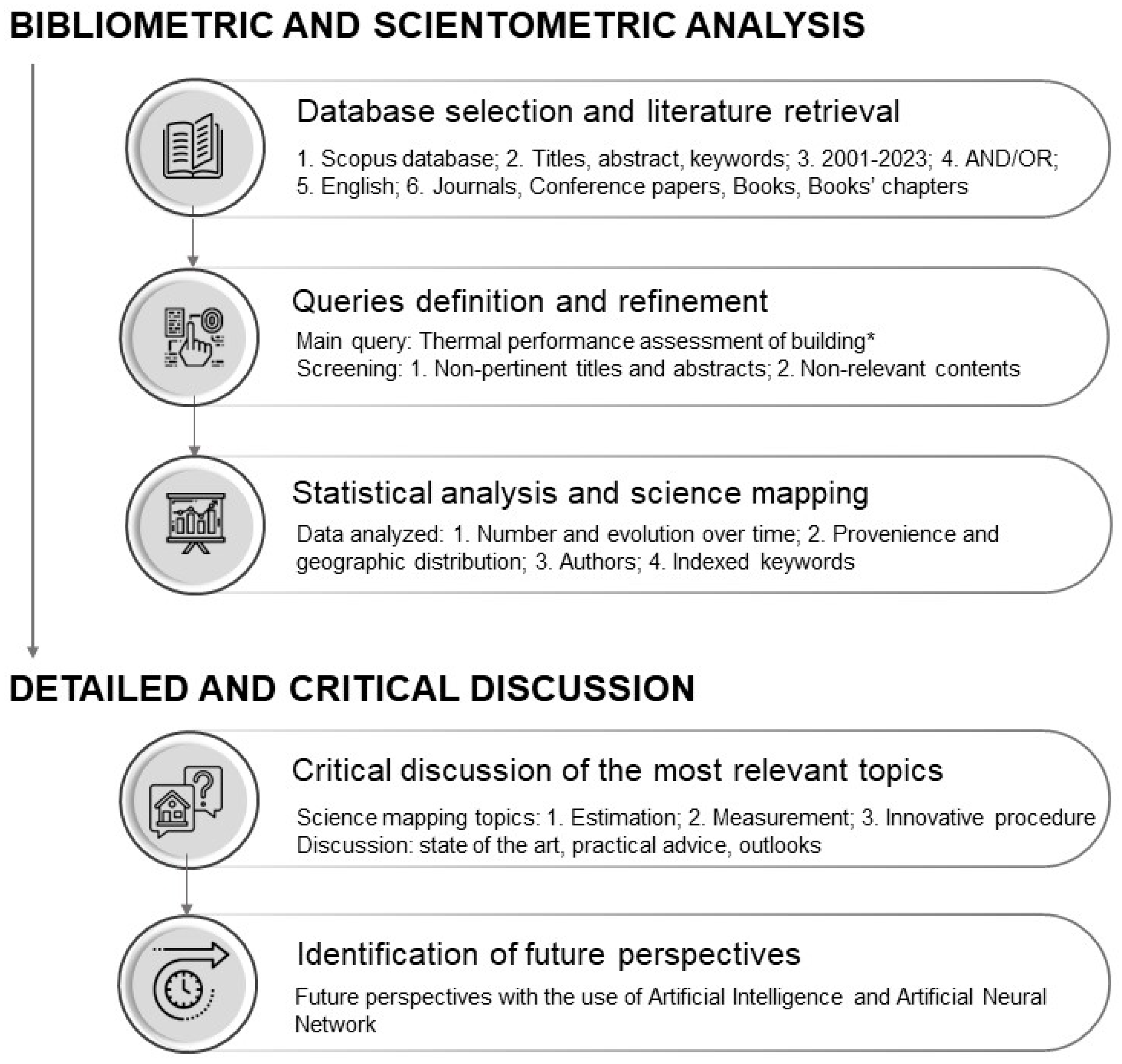
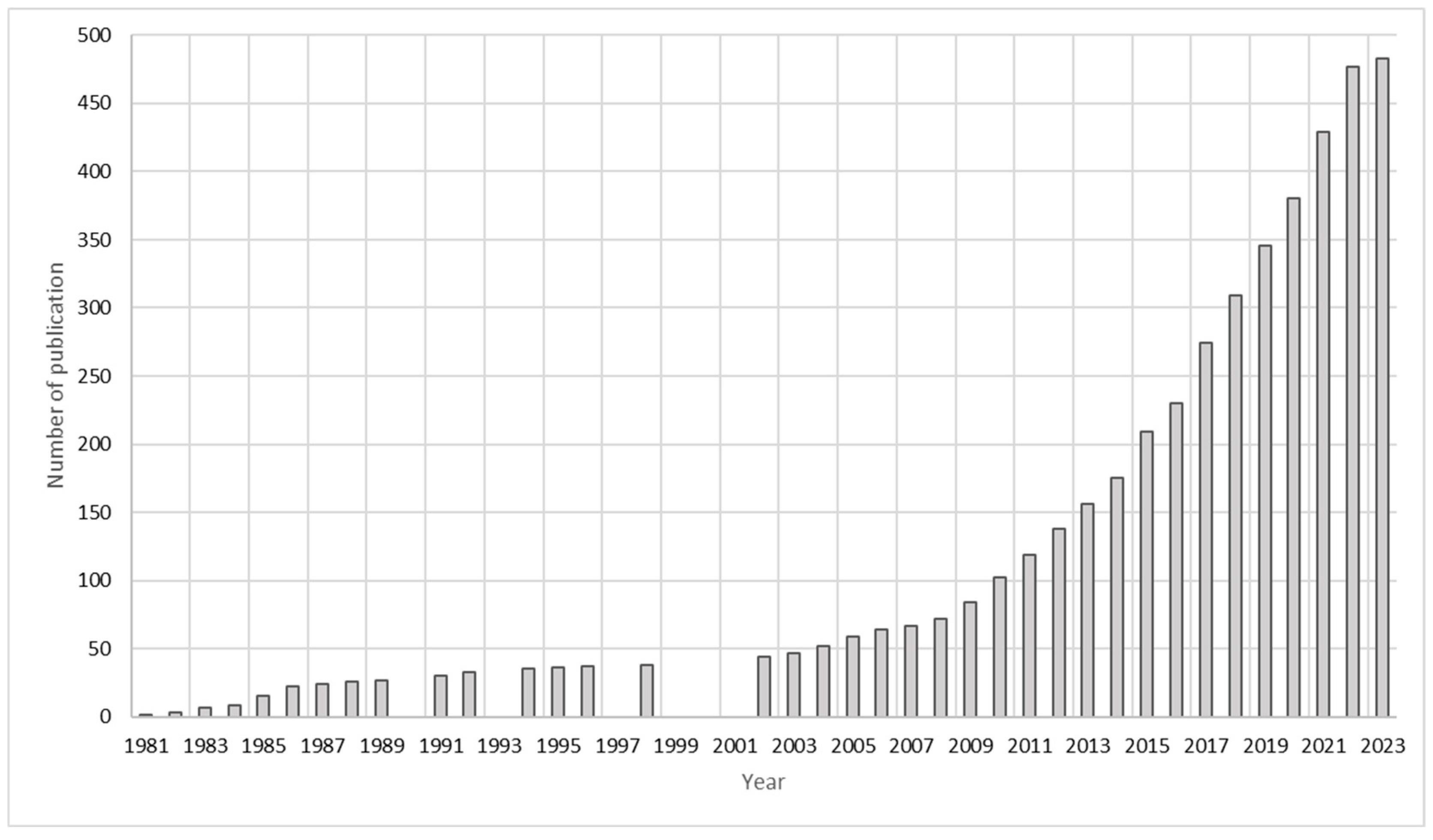
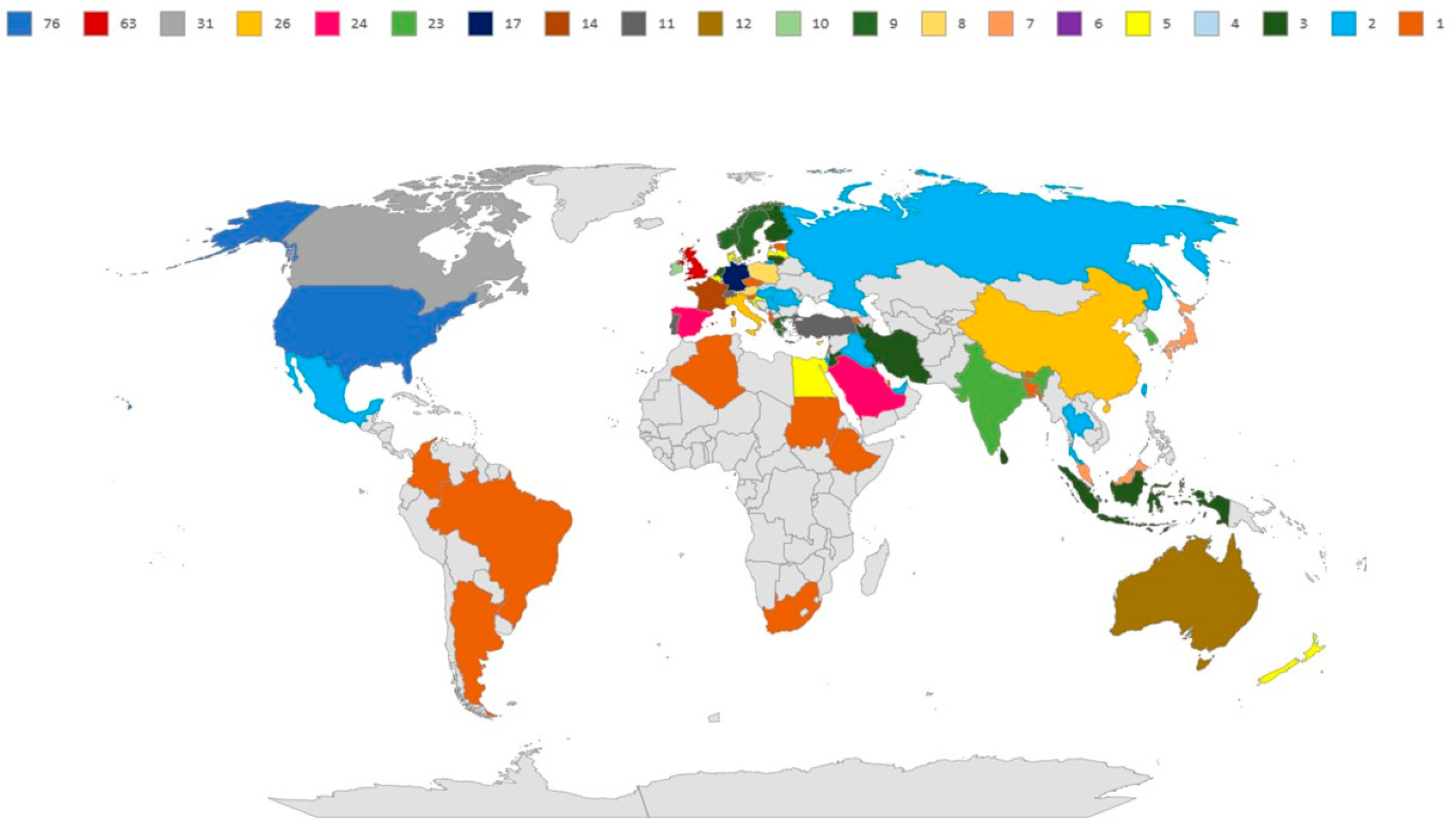
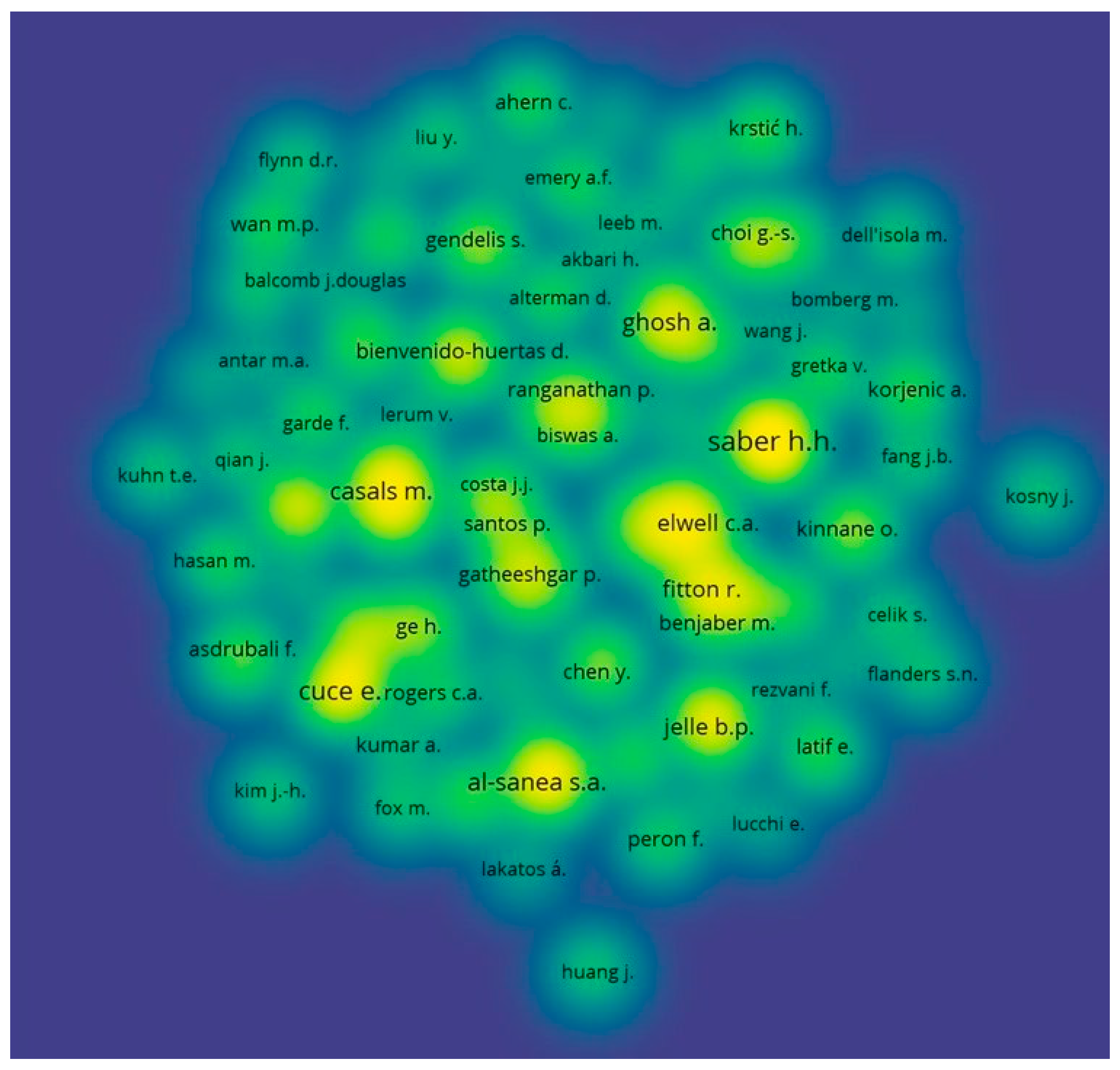
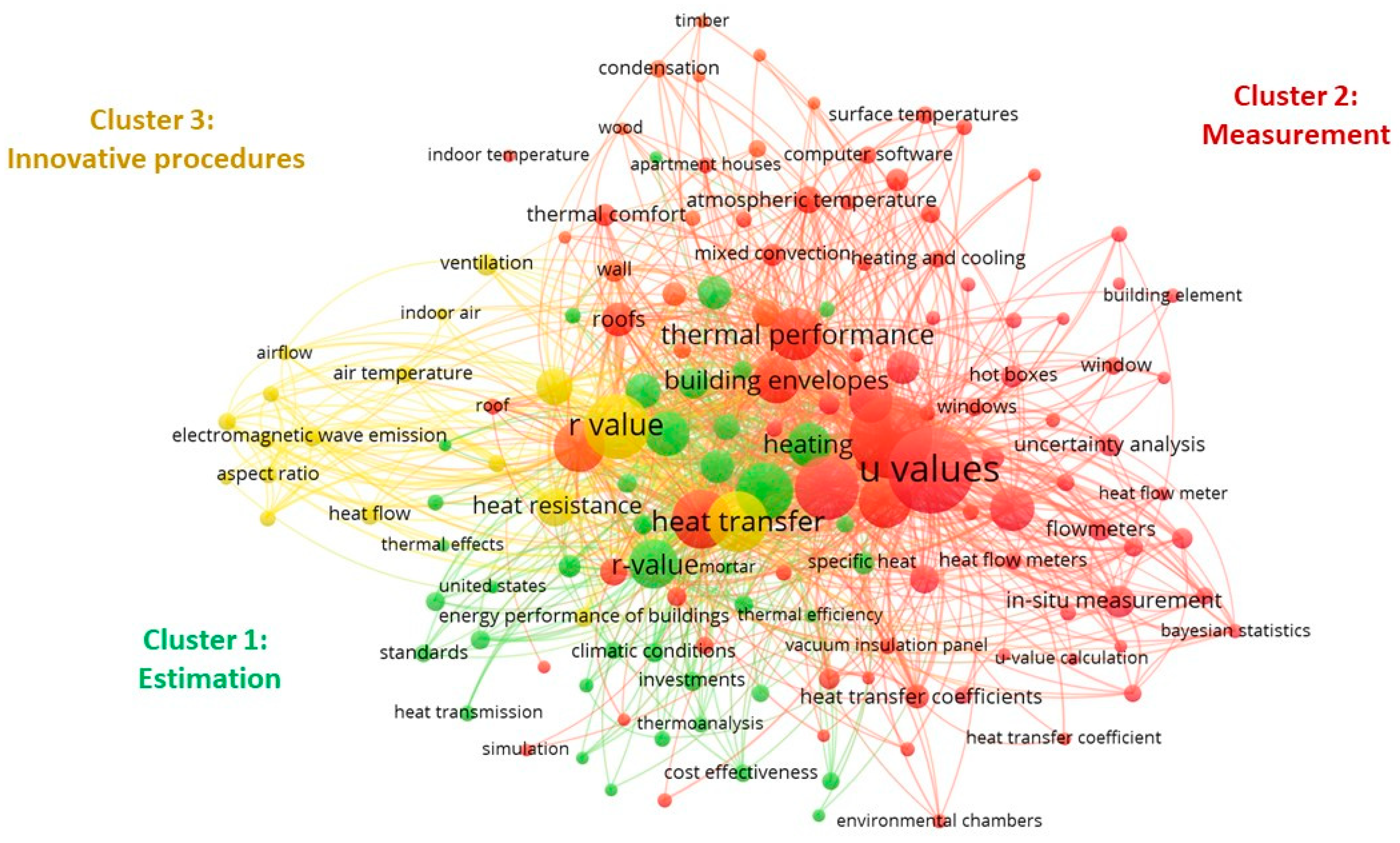
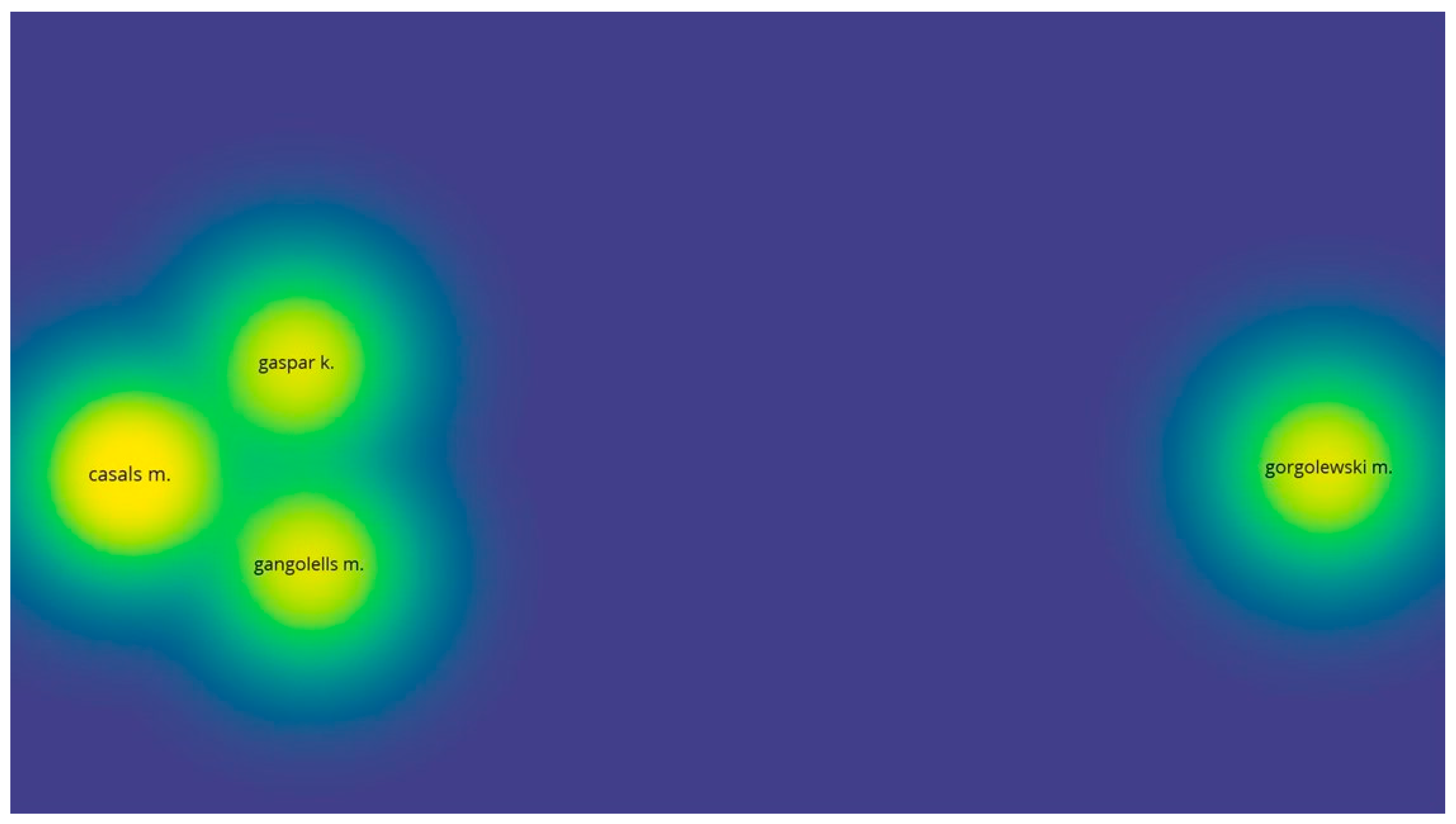
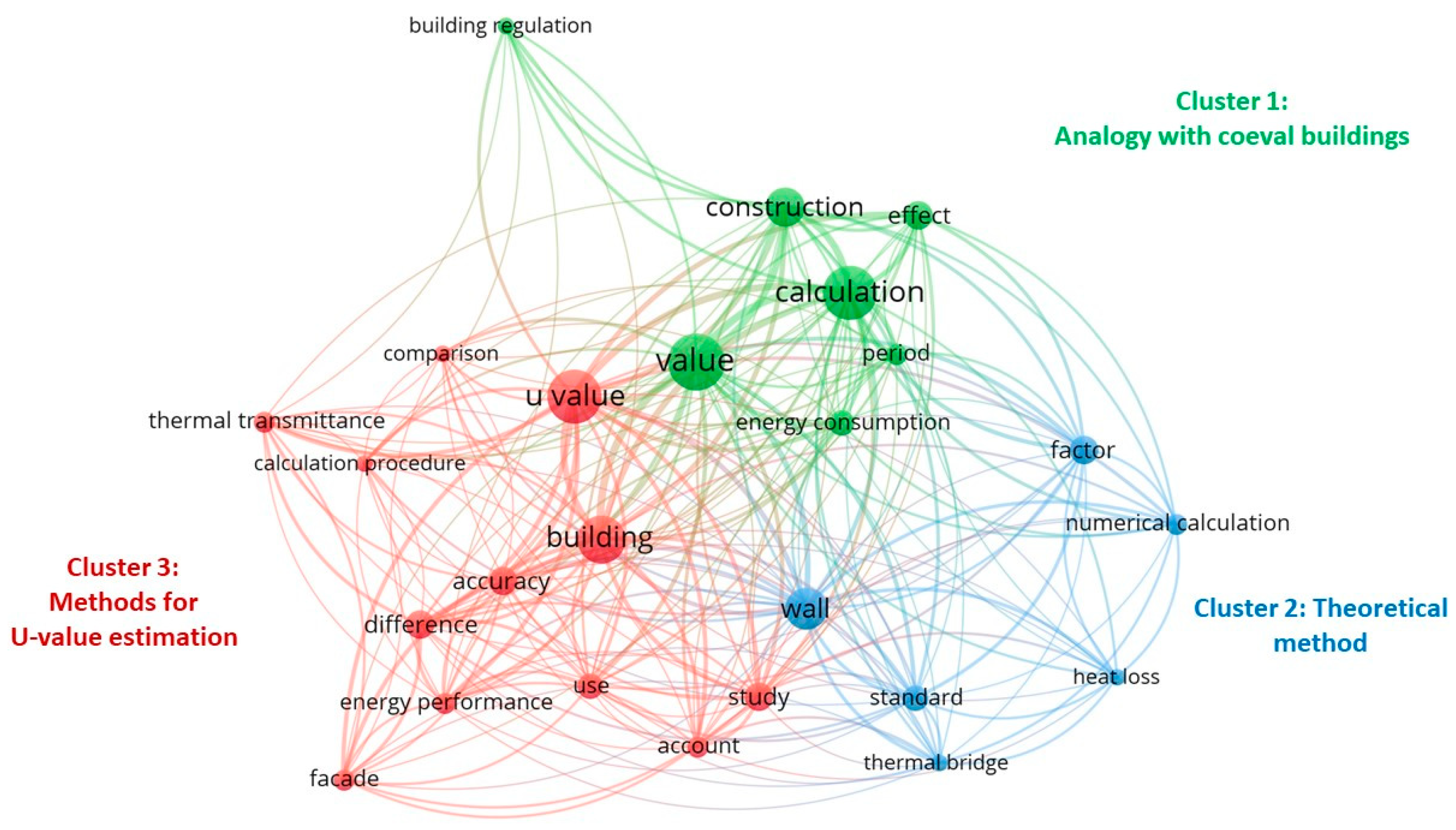

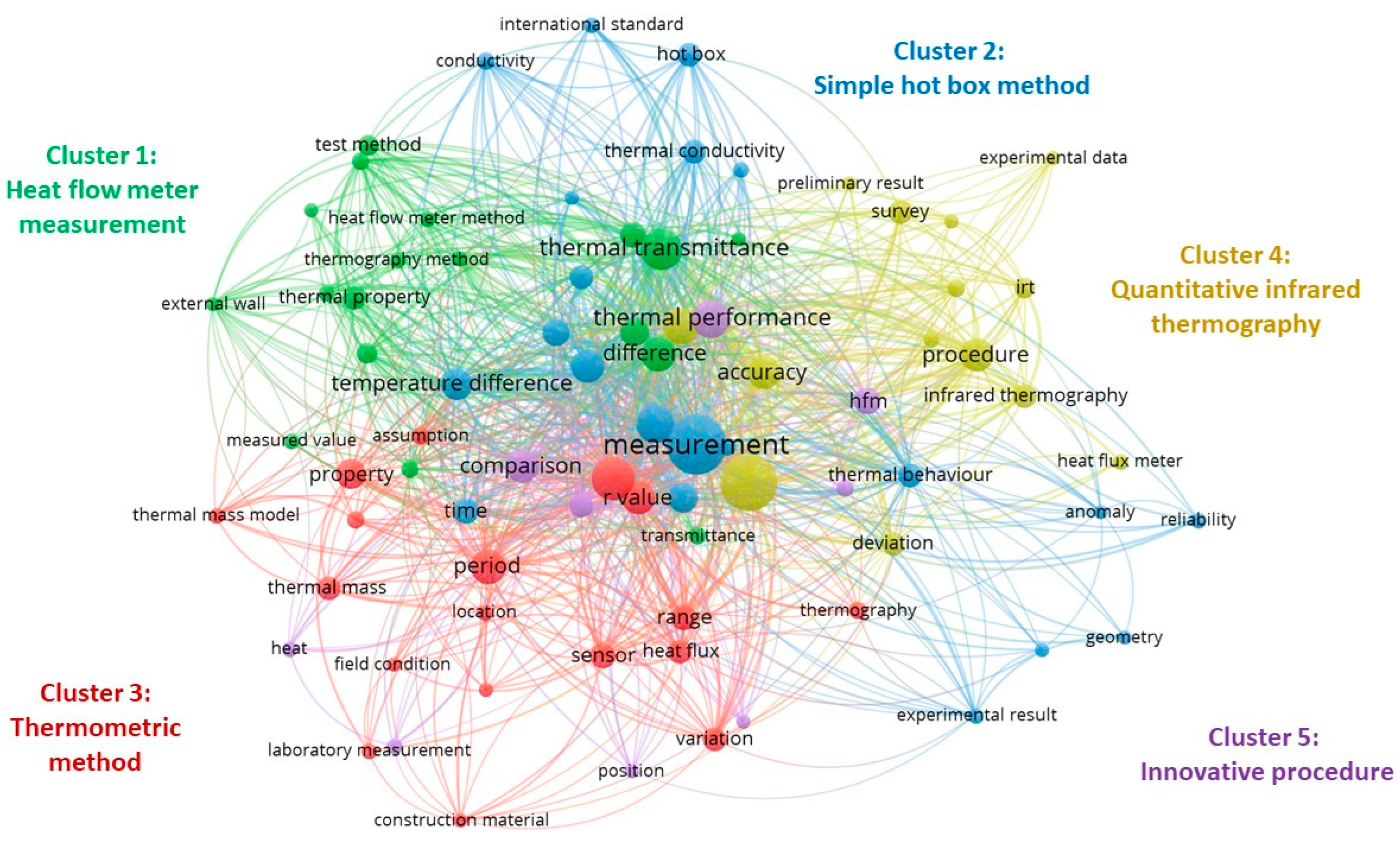
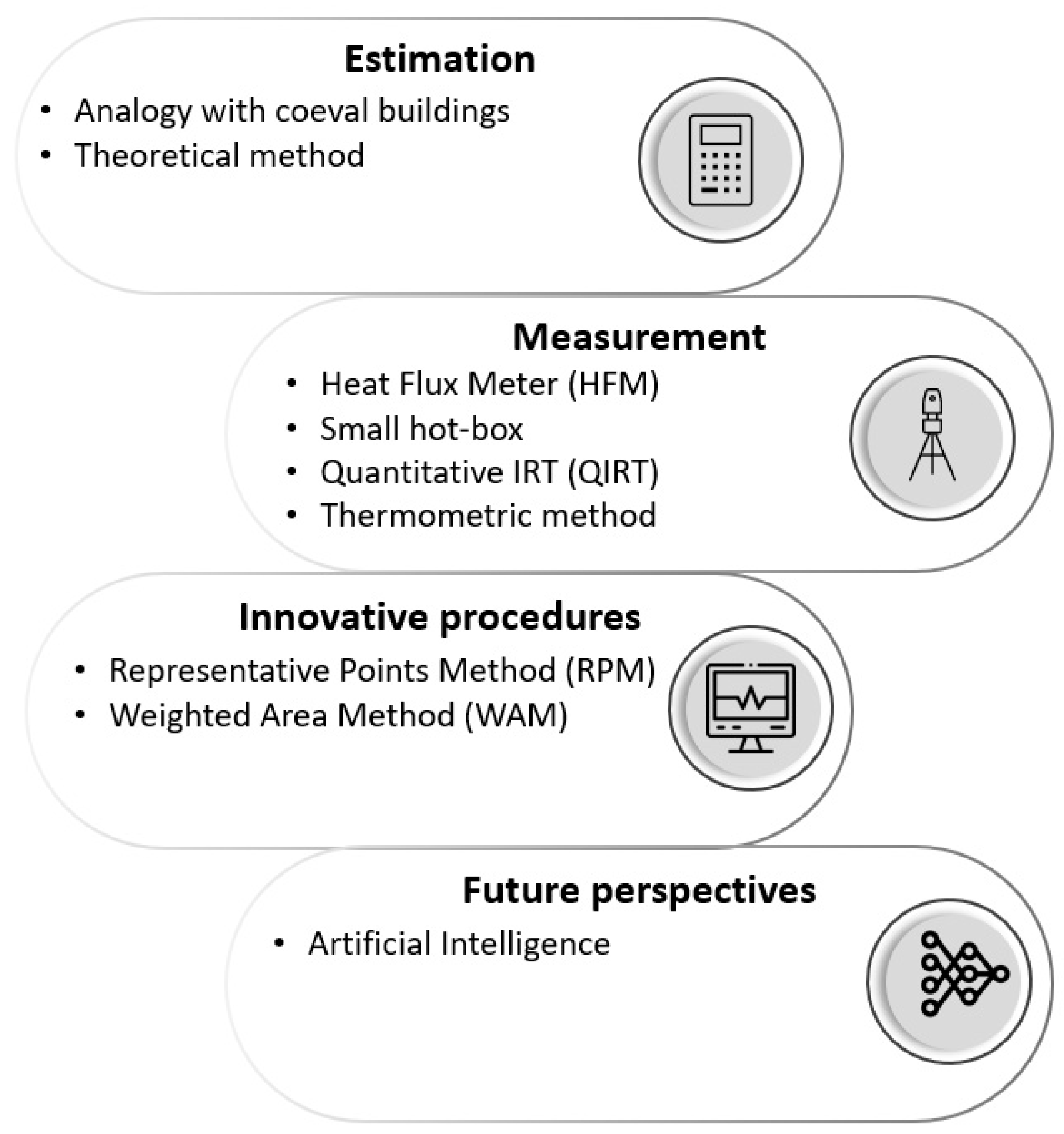
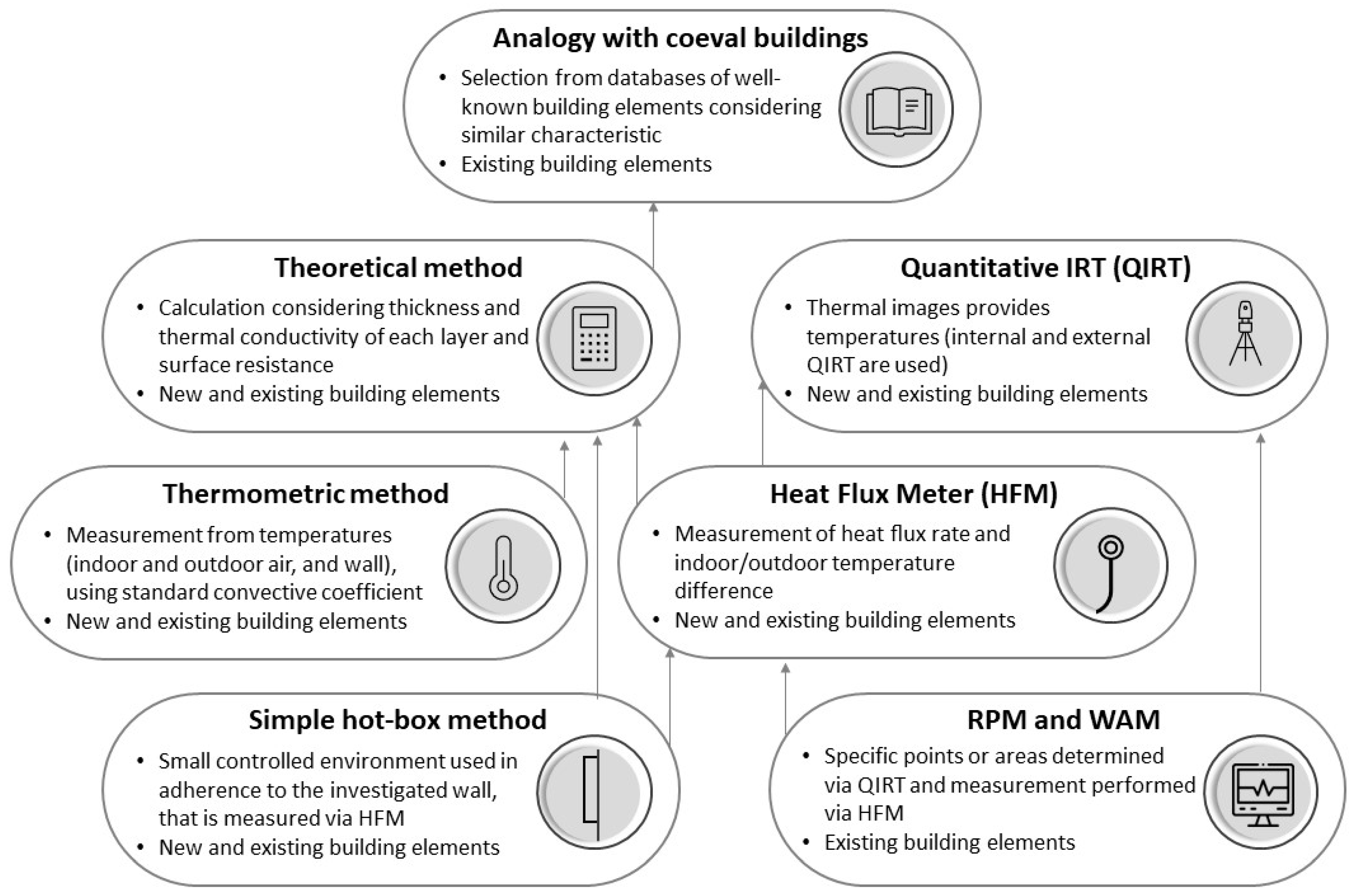
| Query | Number of Publications |
|---|---|
| TITLE-ABS-KEY: “building” * AND “U-value” * OR “R-value” * | 1743 |
| TITLE-ABS-KEY: “building” * AND KEY: “U-value” * OR “R-value” * | 483 |
| KEY: “building” * AND “U-value” * OR “R-value” * | 361 |
| Query | Number of Publications |
|---|---|
| Thermal transmittance estimation of the building envelope | |
| KEY: “building” * AND “U-value” * OR “R-value” * OR TITLE-ABS-KEY: “estimation” * | 15,182 |
| KEY: “building” * AND “U-value” * OR “R-value” * OR TITLE-ABS-KEY: “estimation” * OR “wall” * OR “thermal performance” * | 62,071 |
| KEY: “building” * AND “U-value” * OR “R-value” * AND “estimation” * | 13 |
| Thermal transmittance measurement of the building envelope | |
| KEY 2: “building” * AND “U-value” OR “R-value” * OR TITLE-ABS-KEY 1: “measurement” * | 32,248 |
| KEY 2: “building” * AND “U-value” * OR “R-value” * OR TITLE-ABS-KEY: “measurement” * OR “wall” * OR “thermal performance” * | 60,770 |
| KEY 2: “building” * AND “U-value” * OR “R-value” * AND “measurement” * | 94 |
| Features | Characteristic |
|---|---|
| Opaque building envelope | Retrievable by projects |
| Transparent building envelope | Retrievable by projects or defined by product datasheets |
| Element not considered by databases | |
| Building age | Retrievable by projects, which unfortunately could be missing |
| Retrievable from past and current zoning plans and by the local building permission | |
| U-value retrieval | Country databases can be used (when available and when freely accessible) |
| Multiple databases could interoperate to have a detailed depiction even of small urban contests | |
| Time is mainly spent for the database retrieval | |
| Moisture content and damages are not considered | |
| Quite cheap and quick | |
| Applicability | Walls, roofs, intermediate floors, ground-coupled surfaces such as basement walls and slab-on-grade floors, windows |
| Features | Characteristic |
|---|---|
| Opaque building element | Building structure is retrievable by projects |
| U-value can be identified by mini-destructive techniques, such as endoscope or coring | |
| U-value of the materials are listed by the standards, but they might not correspond to the real ones | |
| Transparent building envelope | Easy calculation for glazing due to the transparency of the element |
| Difficult calculation for windows’ frames due to the structure of the element | |
| Thermal performances of the materials are listed by standards, but they might not correspond to the real ones | |
| U-value retrieval | Quite simple calculation |
| Applicability | Walls, roofs, intermediate floors, ground coupled surfaces such as basement walls and slab-on-grade floors, windows |
| Features | Characteristic |
|---|---|
| HFM plate | Shape and dimension to be chosen according to the structure of the element [19,20] |
| Low R-value for minimizing the perturbation caused by the instrument [31] | |
| High sensitivity for giving sufficiently large signal for the lowest heat flow rates measured [31] | |
| Same colors and emissivity as the building substrate [31] | |
| Ts sensors | Thermocouples and flat resistance thermometers with an accuracy better than + 2% [31] |
| Ta sensors | Thermocouples with an accuracy better than + 2% [13] |
| Thermal conducting paste | λ value similar to the one of the HFM plate [14,16,19,20] |
| Tape | λ value similar to the one of the HFM plate [14,18] |
| Features | Characteristic |
|---|---|
| HFM plate | Mounting adjacent to the more stable temperature to avoid the effect of boundary conditions |
| Use of a thermal conducting paste to the back for ensuring the direct thermal contact with the surface of element [14,15,28,31,36] | |
| Use of low-tack masking tape for reducing the heat flux perturbation generated by the HFM itself [14,28,36,37] | |
| Use of a guard ring realized with similar thermal properties and thickness mounted around the HFM to reduce the thermal exchange [31] | |
| Ts sensors | Mounting adjacent to the more stable temperature to avoid the effect of boundary conditions |
| Use of artificial screening and ventilated for protecting from the variations of the climatic parameters (i.e., sun radiation, υ, and outdoor temperature) [31] | |
| Ta sensors | Needed only for measurement control and validation |
| HFM apparatus | Location on north orientation for minimizing the influence of climatic parameters (i.e., sun radiation, υ, and outdoor temperature) [14,37] |
| Location in a central part of the north-facing walls (about half-way between window and corner, floor and ceiling) for minimizing the influence of vertical stratifications of temperature, heat sources, and thermal bridges [14,30,37] | |
| Location away of sources of heat, such as radiators, fan coils, and lamps, for minimizing the potential influence of heat sources and users on the inner surface [30] | |
| Applicability | Walls, roofs, windows |
| Type | Duration |
|---|---|
| Standard period | Integer multiple of 24 h and at least consecutive 72 h (3 days) [31] |
| It can be reduced reaching stable temperatures on both sides of the element [31,39] | |
| Heavy building elements or thick walls | Integer multiple of 24 h and at least a consecutive 72 h (3 days) [31] |
| 7–30 days to consider the effects of the thermal storage effects related to the thermal inertia of the wall [16,17,18,19,20,30,33,34,35,40,41,42,43] | |
| Light building elements* | Integer multiple of 24 h and at least a consecutive 72 h (3 days) [31] |
| Data should be acquired only during night to avoid the impact of solar radiation [14] | |
| Windows | Integer multiple of 24 h and at least a consecutive 72 h (3 days) [31] |
| Features | Characteristic |
|---|---|
| Size | Depends on wall thickness, wall equivalent thermal conductivity, and temperature difference on the two sides of the wall |
| Minimum dimension can be obtained by a multi-factor coupling regression formula | |
| Probes number | Mounted on the two sides |
| Boundary conditions | Stable values and settled by the user |
| The apparatus can be used in summer | |
| Location | Positioning might be complex |
| Box is mounted on a support structure, which needs to rest on the ground | |
| Walls of buildings not on the ground floor or without balconies are not investigable with this technique | |
| Error | Difference between TBM and HFM ranging from 2–13%, or even higher if compared to the theoretical U-value [48,49] |
| Applicability | Walls |
| Features | Characteristic |
|---|---|
| Ts sensor | Are the only measurement devices needed |
| At least 1 sensor | |
| Ta sensor | At least 2 sensors |
| Probes number | At least 3 probes |
| Possibility of scaling when homemade systems are developed | |
| Preliminary IRT inspection is advisable | |
| Test duration | Few hours [48,49] |
| Possibility of automatically and dynamically adjust test duration according to the conditions [48] | |
| Error | Difference between TBM and HFM ranging between 2–13%, or even higher if compared to the theoretical U-value [48,49] |
| Applicability | Walls |
| Features | Characteristic |
|---|---|
| IR-camera | Low-quality IT cameras are not suitable for quantitative measurement |
| T sensors | Temperatures can be metered only with the IR camera, although for the ease of the use, T probes are used |
| Location | Avoid framing interfering objects (e.g., threes, lightings, furniture, etc.) |
| Convection | Key aspect to be considered |
| Boundary conditions | Avoid solar radiation |
| Avoid windy days | |
| Avoid wet or humid building elements |
Disclaimer/Publisher’s Note: The statements, opinions and data contained in all publications are solely those of the individual author(s) and contributor(s) and not of MDPI and/or the editor(s). MDPI and/or the editor(s) disclaim responsibility for any injury to people or property resulting from any ideas, methods, instructions or products referred to in the content. |
© 2023 by the authors. Licensee MDPI, Basel, Switzerland. This article is an open access article distributed under the terms and conditions of the Creative Commons Attribution (CC BY) license (https://creativecommons.org/licenses/by/4.0/).
Share and Cite
Nardi, I.; Lucchi, E. In Situ Thermal Transmittance Assessment of the Building Envelope: Practical Advice and Outlooks for Standard and Innovative Procedures. Energies 2023, 16, 3319. https://doi.org/10.3390/en16083319
Nardi I, Lucchi E. In Situ Thermal Transmittance Assessment of the Building Envelope: Practical Advice and Outlooks for Standard and Innovative Procedures. Energies. 2023; 16(8):3319. https://doi.org/10.3390/en16083319
Chicago/Turabian StyleNardi, Iole, and Elena Lucchi. 2023. "In Situ Thermal Transmittance Assessment of the Building Envelope: Practical Advice and Outlooks for Standard and Innovative Procedures" Energies 16, no. 8: 3319. https://doi.org/10.3390/en16083319
APA StyleNardi, I., & Lucchi, E. (2023). In Situ Thermal Transmittance Assessment of the Building Envelope: Practical Advice and Outlooks for Standard and Innovative Procedures. Energies, 16(8), 3319. https://doi.org/10.3390/en16083319








